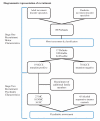SGCE mutations cause psychiatric disorders: clinical and genetic characterization
- PMID: 23365103
- PMCID: PMC4052887
- DOI: 10.1093/brain/aws308
SGCE mutations cause psychiatric disorders: clinical and genetic characterization
Abstract
Myoclonus dystonia syndrome is a childhood onset hyperkinetic movement disorder characterized by predominant alcohol responsive upper body myoclonus and dystonia. A proportion of cases are due to mutations in the maternally imprinted SGCE gene. Previous studies have suggested that patients with SGCE mutations may have an increased rate of psychiatric disorders. We established a cohort of patients with myoclonus dystonia syndrome and SGCE mutations to determine the extent to which psychiatric disorders form part of the disease phenotype. In all, 89 patients with clinically suspected myoclonus dystonia syndrome were recruited from the UK and Ireland. SGCE was analysed using direct sequencing and for copy number variants. In those patients where no mutation was found TOR1A (GAG deletion), GCH1, THAP1 and NKX2-1 were also sequenced. SGCE mutation positive cases were systematically assessed using standardized psychiatric interviews and questionnaires and compared with a disability-matched control group of patients with alcohol responsive tremor. Nineteen (21%) probands had a SGCE mutation, five of which were novel. Recruitment of family members increased the affected SGCE mutation positive group to 27 of whom 21 (77%) had psychiatric symptoms. Obsessive-compulsive disorder was eight times more likely (P < 0.001) in mutation positive cases, compulsivity being the predominant feature (P < 0.001). Generalized anxiety disorder (P = 0.003) and alcohol dependence (P = 0.02) were five times more likely in mutation positive cases than tremor controls. SGCE mutations are associated with a specific psychiatric phenotype consisting of compulsivity, anxiety and alcoholism in addition to the characteristic motor phenotype. SGCE mutations are likely to have a pleiotropic effect in causing both motor and specific psychiatric symptoms.
Figures
Similar articles
-
SGCE and myoclonus dystonia: motor characteristics, diagnostic criteria and clinical predictors of genotype.J Neurol. 2014 Dec;261(12):2296-304. doi: 10.1007/s00415-014-7488-3. Epub 2014 Sep 11. J Neurol. 2014. PMID: 25209853 Free PMC article.
-
Myoclonus-dystonia, obsessive-compulsive disorder, and alcohol dependence in SGCE mutation carriers.Neurology. 2007 Feb 13;68(7):522-4. doi: 10.1212/01.wnl.0000253188.76092.06. Neurology. 2007. PMID: 17296918
-
[Clinical and genetic analysis of childhood-onset myoclonus dystonia syndrome caused by SGCE variants].Zhonghua Er Ke Za Zhi. 2020 Feb 2;58(2):123-128. doi: 10.3760/cma.j.issn.0578-1310.2020.02.011. Zhonghua Er Ke Za Zhi. 2020. PMID: 32102149 Chinese.
-
Incomplete nonsense-mediated decay facilitates detection of a multi-exonic deletion mutation in SGCE.Clin Genet. 2013 Sep;84(3):276-80. doi: 10.1111/cge.12059. Epub 2012 Nov 30. Clin Genet. 2013. PMID: 23140253 Review.
-
Genetic Aspects of Myoclonus-Dystonia Syndrome (MDS).Mol Neurobiol. 2017 Mar;54(2):939-942. doi: 10.1007/s12035-016-9712-x. Epub 2016 Jan 20. Mol Neurobiol. 2017. PMID: 26790671 Review.
Cited by
-
A guide to childhood motor stereotypies, tic disorders and the tourette spectrum for the primary care practitioner.Ulster Med J. 2014 Jan;83(1):22-30. Ulster Med J. 2014. PMID: 24757265 Free PMC article. Review.
-
Cognitive and Neuropsychiatric Impairment in Dystonia.Curr Neurol Neurosci Rep. 2022 Nov;22(11):699-708. doi: 10.1007/s11910-022-01233-3. Epub 2022 Oct 6. Curr Neurol Neurosci Rep. 2022. PMID: 36201146 Free PMC article. Review.
-
Genetic studies of alcohol dependence in the context of the addiction cycle.Neuropharmacology. 2017 Aug 1;122:3-21. doi: 10.1016/j.neuropharm.2017.01.017. Epub 2017 Jan 22. Neuropharmacology. 2017. PMID: 28118990 Free PMC article. Review.
-
Low CSF 5-HIAA in Myoclonus Dystonia.Mov Disord. 2017 Nov;32(11):1647-1649. doi: 10.1002/mds.27117. Epub 2017 Sep 26. Mov Disord. 2017. PMID: 28949039 Free PMC article. No abstract available.
-
Dystonia genes functionally converge in specific neurons and share neurobiology with psychiatric disorders.Brain. 2020 Sep 1;143(9):2771-2787. doi: 10.1093/brain/awaa217. Brain. 2020. PMID: 32889528 Free PMC article.
References
-
- Asmus F, Zimprich A, Tezenas Du Montcel S, Kabus C, Deuschl G, Kupsch A, et al. Myoclonus-dystonia syndrome: epsilon-sarcoglycan mutations and phenotype. Ann Neurol. 2002;52:489–92. - PubMed
-
- Asmus F, Salih F, Hjermind LE, Ostergaard K, Munz M, Kühn AA, et al. Myoclonus-dystonia due to genomic deletions in the epsilon-sarcoglycan gene. Ann Neurol. 2005;58:792–7. - PubMed
-
- Asmus F, Hjermind LE, Dupont E, Wagenstaller J, Haberlandt E, Munz M, et al. Genomic deletion size at the epsilon-sarcoglycan locus determines the clinical phenotype. Brain. 2007;130:2736–45. - PubMed
-
- Asmus F, Langseth A, Doherty E, Nestor T, Munz M, Gasser T, et al. “Jerky” dystonia in children: spectrum of phenotypes and genetic testing. Mov Disord. 2009;24:702–9. - PubMed
-
- Azoulay-Zyss J, Roze E, Welter ML, Navarro S, Yelnik J, Clot F, et al. Bilateral deep brain stimulation of the pallidum for myoclonus-dystonia due to epsilon-sarcoglycan mutations: a pilot study. Arch Neurol. 2011;68:94–8. - PubMed
Publication types
MeSH terms
Substances
Grants and funding
LinkOut - more resources
Full Text Sources
Other Literature Sources
Medical


